Couple Therapy Plan: Edward and Connie
VerifiedAdded on 2020/03/13
|8
|2228
|48
AI Summary
This assignment presents a detailed couple therapy plan for Edward and Connie Summer. The plan incorporates both psychodynamic and Gottman's approach to couple therapy, addressing their communication difficulties, emotional detachment, and conflict resolution challenges. It outlines specific goals, interventions, and progress monitoring strategies designed to improve their relationship dynamics.
Contribute Materials
Your contribution can guide someone’s learning journey. Share your
documents today.

Running head: RELATIONSHIP COUNSELLING
The couple therapy: Connecting to two theories and concepts
Name of the student:
Name of the University:
Author note:
The couple therapy: Connecting to two theories and concepts
Name of the student:
Name of the University:
Author note:
Secure Best Marks with AI Grader
Need help grading? Try our AI Grader for instant feedback on your assignments.
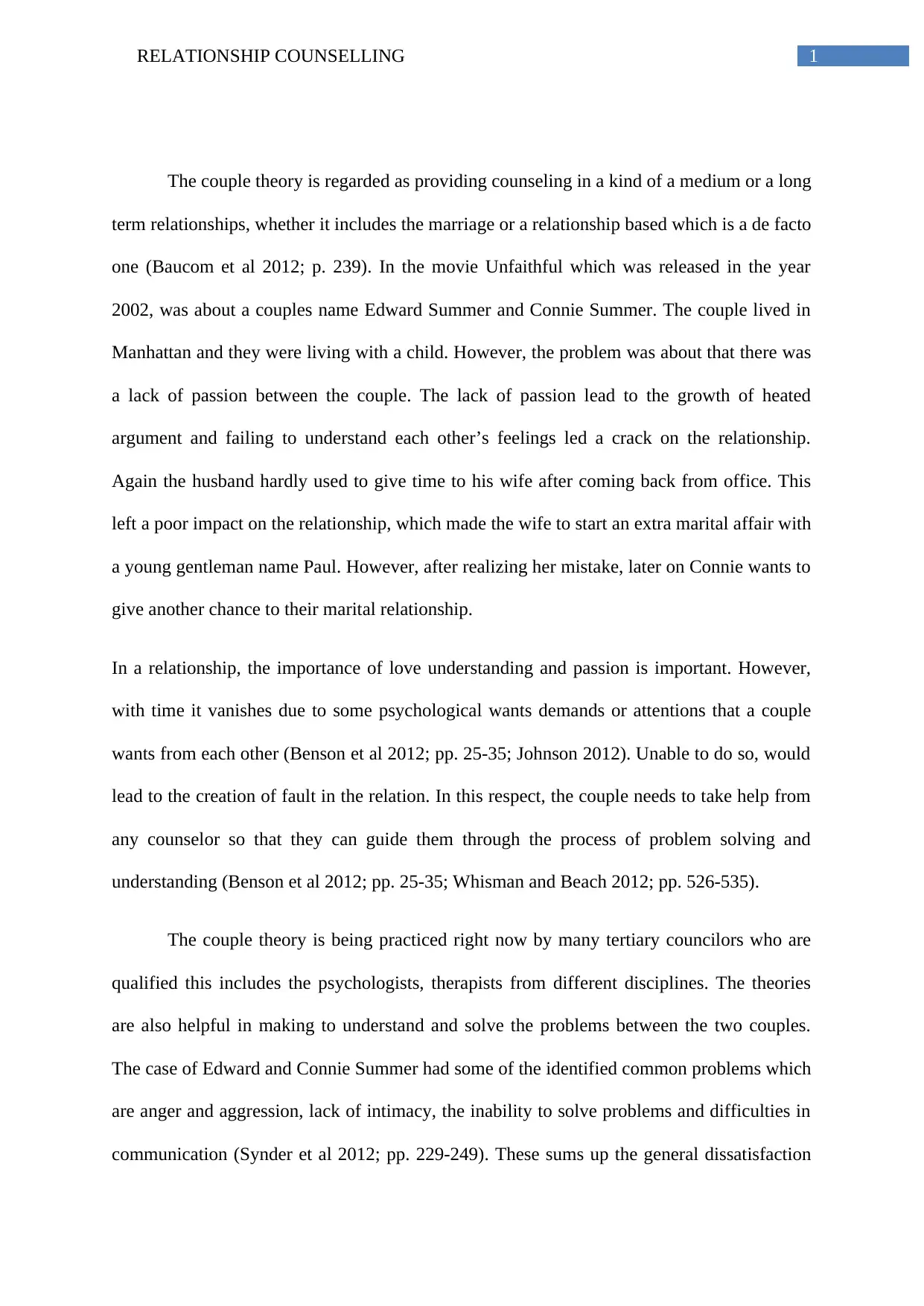
1RELATIONSHIP COUNSELLING
The couple theory is regarded as providing counseling in a kind of a medium or a long
term relationships, whether it includes the marriage or a relationship based which is a de facto
one (Baucom et al 2012; p. 239). In the movie Unfaithful which was released in the year
2002, was about a couples name Edward Summer and Connie Summer. The couple lived in
Manhattan and they were living with a child. However, the problem was about that there was
a lack of passion between the couple. The lack of passion lead to the growth of heated
argument and failing to understand each other’s feelings led a crack on the relationship.
Again the husband hardly used to give time to his wife after coming back from office. This
left a poor impact on the relationship, which made the wife to start an extra marital affair with
a young gentleman name Paul. However, after realizing her mistake, later on Connie wants to
give another chance to their marital relationship.
In a relationship, the importance of love understanding and passion is important. However,
with time it vanishes due to some psychological wants demands or attentions that a couple
wants from each other (Benson et al 2012; pp. 25-35; Johnson 2012). Unable to do so, would
lead to the creation of fault in the relation. In this respect, the couple needs to take help from
any counselor so that they can guide them through the process of problem solving and
understanding (Benson et al 2012; pp. 25-35; Whisman and Beach 2012; pp. 526-535).
The couple theory is being practiced right now by many tertiary councilors who are
qualified this includes the psychologists, therapists from different disciplines. The theories
are also helpful in making to understand and solve the problems between the two couples.
The case of Edward and Connie Summer had some of the identified common problems which
are anger and aggression, lack of intimacy, the inability to solve problems and difficulties in
communication (Synder et al 2012; pp. 229-249). These sums up the general dissatisfaction
The couple theory is regarded as providing counseling in a kind of a medium or a long
term relationships, whether it includes the marriage or a relationship based which is a de facto
one (Baucom et al 2012; p. 239). In the movie Unfaithful which was released in the year
2002, was about a couples name Edward Summer and Connie Summer. The couple lived in
Manhattan and they were living with a child. However, the problem was about that there was
a lack of passion between the couple. The lack of passion lead to the growth of heated
argument and failing to understand each other’s feelings led a crack on the relationship.
Again the husband hardly used to give time to his wife after coming back from office. This
left a poor impact on the relationship, which made the wife to start an extra marital affair with
a young gentleman name Paul. However, after realizing her mistake, later on Connie wants to
give another chance to their marital relationship.
In a relationship, the importance of love understanding and passion is important. However,
with time it vanishes due to some psychological wants demands or attentions that a couple
wants from each other (Benson et al 2012; pp. 25-35; Johnson 2012). Unable to do so, would
lead to the creation of fault in the relation. In this respect, the couple needs to take help from
any counselor so that they can guide them through the process of problem solving and
understanding (Benson et al 2012; pp. 25-35; Whisman and Beach 2012; pp. 526-535).
The couple theory is being practiced right now by many tertiary councilors who are
qualified this includes the psychologists, therapists from different disciplines. The theories
are also helpful in making to understand and solve the problems between the two couples.
The case of Edward and Connie Summer had some of the identified common problems which
are anger and aggression, lack of intimacy, the inability to solve problems and difficulties in
communication (Synder et al 2012; pp. 229-249). These sums up the general dissatisfaction
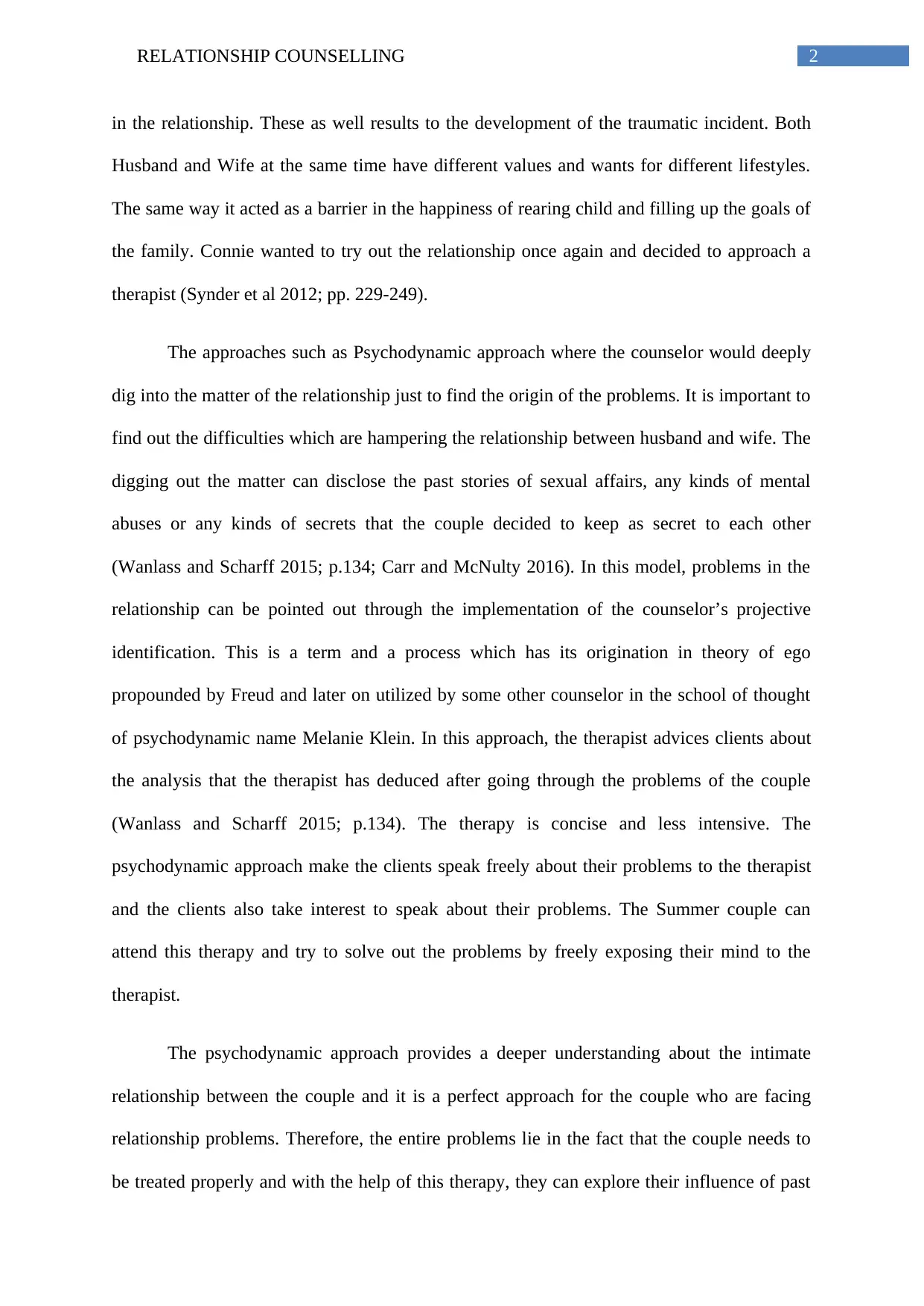
2RELATIONSHIP COUNSELLING
in the relationship. These as well results to the development of the traumatic incident. Both
Husband and Wife at the same time have different values and wants for different lifestyles.
The same way it acted as a barrier in the happiness of rearing child and filling up the goals of
the family. Connie wanted to try out the relationship once again and decided to approach a
therapist (Synder et al 2012; pp. 229-249).
The approaches such as Psychodynamic approach where the counselor would deeply
dig into the matter of the relationship just to find the origin of the problems. It is important to
find out the difficulties which are hampering the relationship between husband and wife. The
digging out the matter can disclose the past stories of sexual affairs, any kinds of mental
abuses or any kinds of secrets that the couple decided to keep as secret to each other
(Wanlass and Scharff 2015; p.134; Carr and McNulty 2016). In this model, problems in the
relationship can be pointed out through the implementation of the counselor’s projective
identification. This is a term and a process which has its origination in theory of ego
propounded by Freud and later on utilized by some other counselor in the school of thought
of psychodynamic name Melanie Klein. In this approach, the therapist advices clients about
the analysis that the therapist has deduced after going through the problems of the couple
(Wanlass and Scharff 2015; p.134). The therapy is concise and less intensive. The
psychodynamic approach make the clients speak freely about their problems to the therapist
and the clients also take interest to speak about their problems. The Summer couple can
attend this therapy and try to solve out the problems by freely exposing their mind to the
therapist.
The psychodynamic approach provides a deeper understanding about the intimate
relationship between the couple and it is a perfect approach for the couple who are facing
relationship problems. Therefore, the entire problems lie in the fact that the couple needs to
be treated properly and with the help of this therapy, they can explore their influence of past
in the relationship. These as well results to the development of the traumatic incident. Both
Husband and Wife at the same time have different values and wants for different lifestyles.
The same way it acted as a barrier in the happiness of rearing child and filling up the goals of
the family. Connie wanted to try out the relationship once again and decided to approach a
therapist (Synder et al 2012; pp. 229-249).
The approaches such as Psychodynamic approach where the counselor would deeply
dig into the matter of the relationship just to find the origin of the problems. It is important to
find out the difficulties which are hampering the relationship between husband and wife. The
digging out the matter can disclose the past stories of sexual affairs, any kinds of mental
abuses or any kinds of secrets that the couple decided to keep as secret to each other
(Wanlass and Scharff 2015; p.134; Carr and McNulty 2016). In this model, problems in the
relationship can be pointed out through the implementation of the counselor’s projective
identification. This is a term and a process which has its origination in theory of ego
propounded by Freud and later on utilized by some other counselor in the school of thought
of psychodynamic name Melanie Klein. In this approach, the therapist advices clients about
the analysis that the therapist has deduced after going through the problems of the couple
(Wanlass and Scharff 2015; p.134). The therapy is concise and less intensive. The
psychodynamic approach make the clients speak freely about their problems to the therapist
and the clients also take interest to speak about their problems. The Summer couple can
attend this therapy and try to solve out the problems by freely exposing their mind to the
therapist.
The psychodynamic approach provides a deeper understanding about the intimate
relationship between the couple and it is a perfect approach for the couple who are facing
relationship problems. Therefore, the entire problems lie in the fact that the couple needs to
be treated properly and with the help of this therapy, they can explore their influence of past
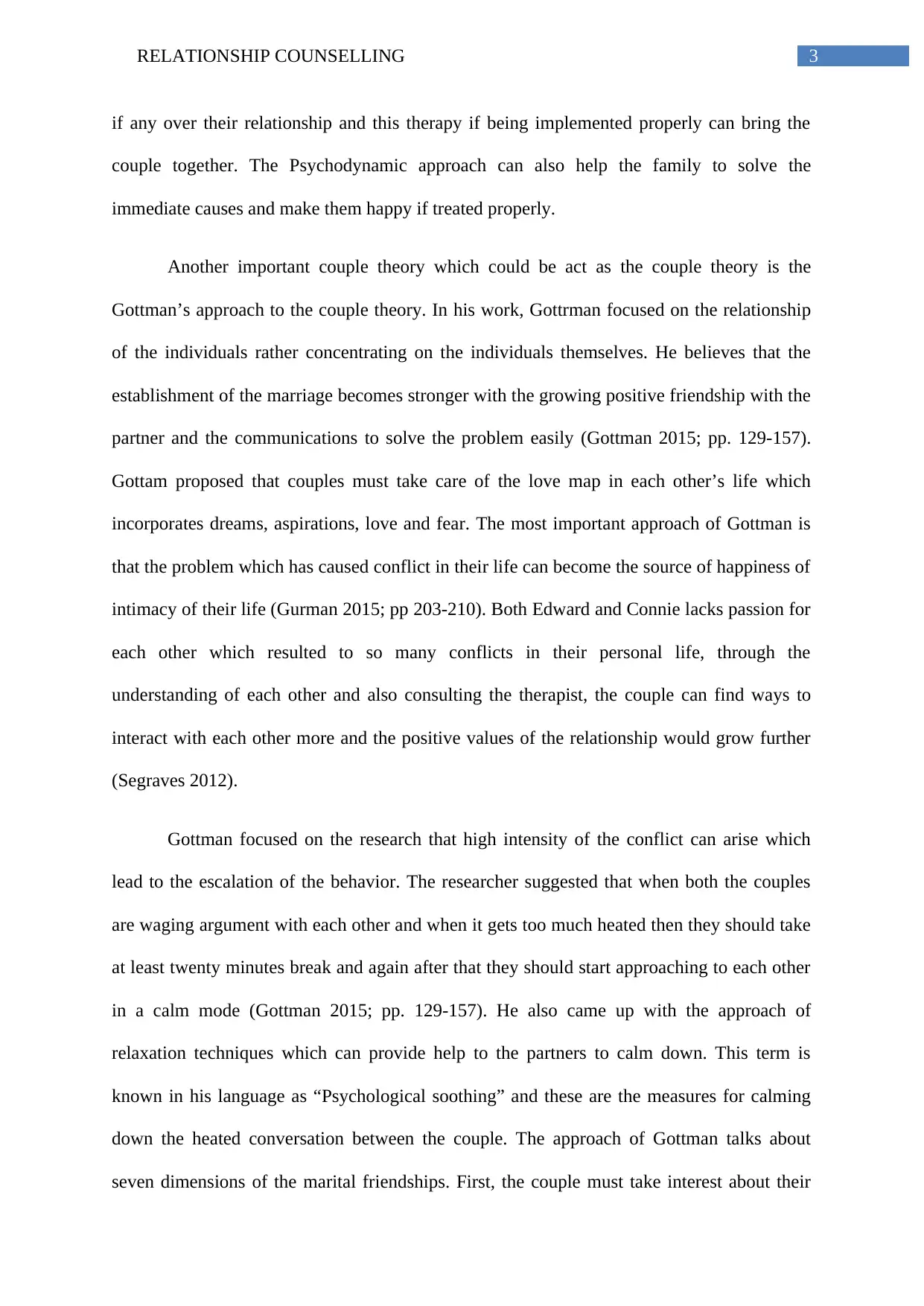
3RELATIONSHIP COUNSELLING
if any over their relationship and this therapy if being implemented properly can bring the
couple together. The Psychodynamic approach can also help the family to solve the
immediate causes and make them happy if treated properly.
Another important couple theory which could be act as the couple theory is the
Gottman’s approach to the couple theory. In his work, Gottrman focused on the relationship
of the individuals rather concentrating on the individuals themselves. He believes that the
establishment of the marriage becomes stronger with the growing positive friendship with the
partner and the communications to solve the problem easily (Gottman 2015; pp. 129-157).
Gottam proposed that couples must take care of the love map in each other’s life which
incorporates dreams, aspirations, love and fear. The most important approach of Gottman is
that the problem which has caused conflict in their life can become the source of happiness of
intimacy of their life (Gurman 2015; pp 203-210). Both Edward and Connie lacks passion for
each other which resulted to so many conflicts in their personal life, through the
understanding of each other and also consulting the therapist, the couple can find ways to
interact with each other more and the positive values of the relationship would grow further
(Segraves 2012).
Gottman focused on the research that high intensity of the conflict can arise which
lead to the escalation of the behavior. The researcher suggested that when both the couples
are waging argument with each other and when it gets too much heated then they should take
at least twenty minutes break and again after that they should start approaching to each other
in a calm mode (Gottman 2015; pp. 129-157). He also came up with the approach of
relaxation techniques which can provide help to the partners to calm down. This term is
known in his language as “Psychological soothing” and these are the measures for calming
down the heated conversation between the couple. The approach of Gottman talks about
seven dimensions of the marital friendships. First, the couple must take interest about their
if any over their relationship and this therapy if being implemented properly can bring the
couple together. The Psychodynamic approach can also help the family to solve the
immediate causes and make them happy if treated properly.
Another important couple theory which could be act as the couple theory is the
Gottman’s approach to the couple theory. In his work, Gottrman focused on the relationship
of the individuals rather concentrating on the individuals themselves. He believes that the
establishment of the marriage becomes stronger with the growing positive friendship with the
partner and the communications to solve the problem easily (Gottman 2015; pp. 129-157).
Gottam proposed that couples must take care of the love map in each other’s life which
incorporates dreams, aspirations, love and fear. The most important approach of Gottman is
that the problem which has caused conflict in their life can become the source of happiness of
intimacy of their life (Gurman 2015; pp 203-210). Both Edward and Connie lacks passion for
each other which resulted to so many conflicts in their personal life, through the
understanding of each other and also consulting the therapist, the couple can find ways to
interact with each other more and the positive values of the relationship would grow further
(Segraves 2012).
Gottman focused on the research that high intensity of the conflict can arise which
lead to the escalation of the behavior. The researcher suggested that when both the couples
are waging argument with each other and when it gets too much heated then they should take
at least twenty minutes break and again after that they should start approaching to each other
in a calm mode (Gottman 2015; pp. 129-157). He also came up with the approach of
relaxation techniques which can provide help to the partners to calm down. This term is
known in his language as “Psychological soothing” and these are the measures for calming
down the heated conversation between the couple. The approach of Gottman talks about
seven dimensions of the marital friendships. First, the couple must take interest about their
Secure Best Marks with AI Grader
Need help grading? Try our AI Grader for instant feedback on your assignments.
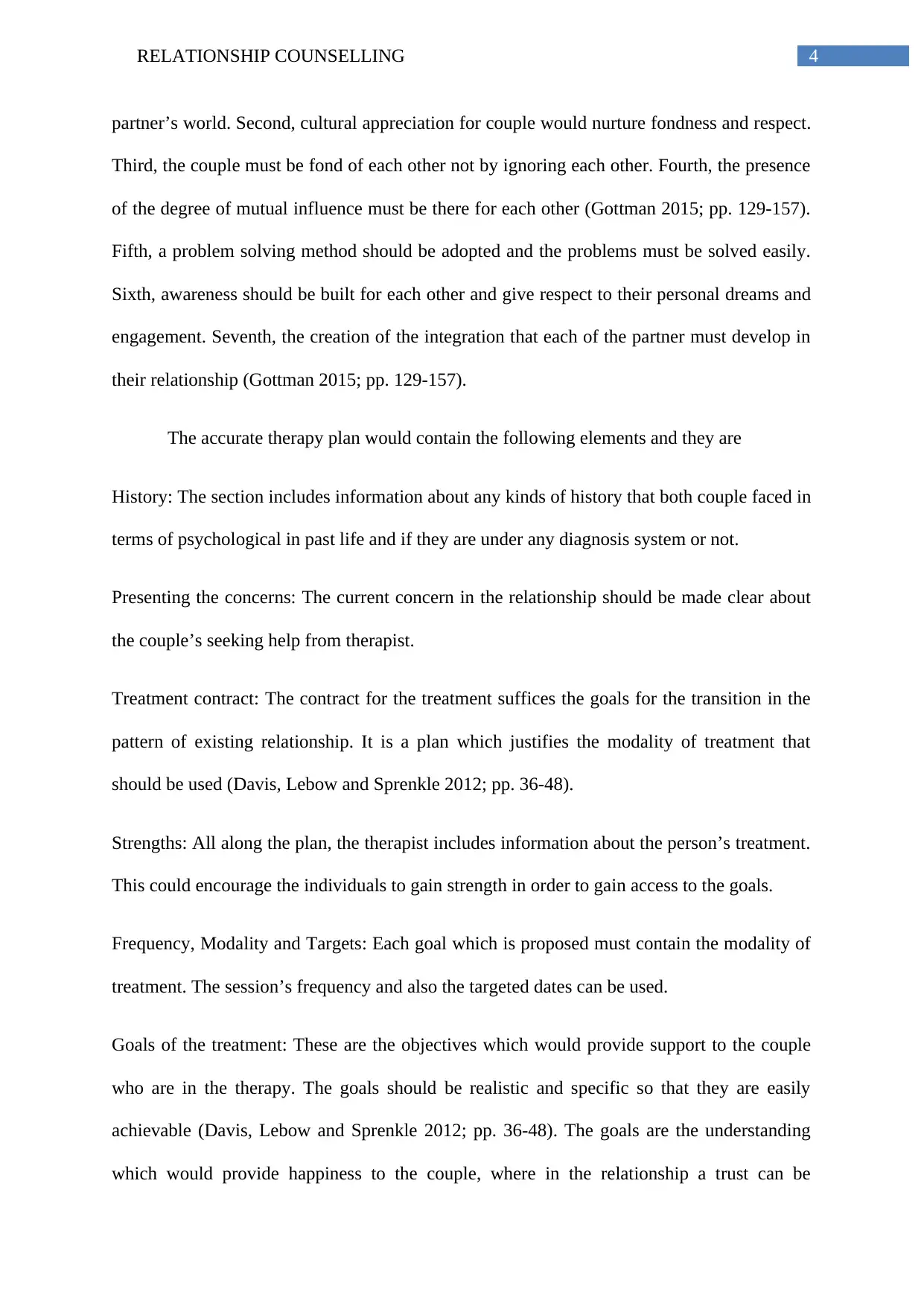
4RELATIONSHIP COUNSELLING
partner’s world. Second, cultural appreciation for couple would nurture fondness and respect.
Third, the couple must be fond of each other not by ignoring each other. Fourth, the presence
of the degree of mutual influence must be there for each other (Gottman 2015; pp. 129-157).
Fifth, a problem solving method should be adopted and the problems must be solved easily.
Sixth, awareness should be built for each other and give respect to their personal dreams and
engagement. Seventh, the creation of the integration that each of the partner must develop in
their relationship (Gottman 2015; pp. 129-157).
The accurate therapy plan would contain the following elements and they are
History: The section includes information about any kinds of history that both couple faced in
terms of psychological in past life and if they are under any diagnosis system or not.
Presenting the concerns: The current concern in the relationship should be made clear about
the couple’s seeking help from therapist.
Treatment contract: The contract for the treatment suffices the goals for the transition in the
pattern of existing relationship. It is a plan which justifies the modality of treatment that
should be used (Davis, Lebow and Sprenkle 2012; pp. 36-48).
Strengths: All along the plan, the therapist includes information about the person’s treatment.
This could encourage the individuals to gain strength in order to gain access to the goals.
Frequency, Modality and Targets: Each goal which is proposed must contain the modality of
treatment. The session’s frequency and also the targeted dates can be used.
Goals of the treatment: These are the objectives which would provide support to the couple
who are in the therapy. The goals should be realistic and specific so that they are easily
achievable (Davis, Lebow and Sprenkle 2012; pp. 36-48). The goals are the understanding
which would provide happiness to the couple, where in the relationship a trust can be
partner’s world. Second, cultural appreciation for couple would nurture fondness and respect.
Third, the couple must be fond of each other not by ignoring each other. Fourth, the presence
of the degree of mutual influence must be there for each other (Gottman 2015; pp. 129-157).
Fifth, a problem solving method should be adopted and the problems must be solved easily.
Sixth, awareness should be built for each other and give respect to their personal dreams and
engagement. Seventh, the creation of the integration that each of the partner must develop in
their relationship (Gottman 2015; pp. 129-157).
The accurate therapy plan would contain the following elements and they are
History: The section includes information about any kinds of history that both couple faced in
terms of psychological in past life and if they are under any diagnosis system or not.
Presenting the concerns: The current concern in the relationship should be made clear about
the couple’s seeking help from therapist.
Treatment contract: The contract for the treatment suffices the goals for the transition in the
pattern of existing relationship. It is a plan which justifies the modality of treatment that
should be used (Davis, Lebow and Sprenkle 2012; pp. 36-48).
Strengths: All along the plan, the therapist includes information about the person’s treatment.
This could encourage the individuals to gain strength in order to gain access to the goals.
Frequency, Modality and Targets: Each goal which is proposed must contain the modality of
treatment. The session’s frequency and also the targeted dates can be used.
Goals of the treatment: These are the objectives which would provide support to the couple
who are in the therapy. The goals should be realistic and specific so that they are easily
achievable (Davis, Lebow and Sprenkle 2012; pp. 36-48). The goals are the understanding
which would provide happiness to the couple, where in the relationship a trust can be
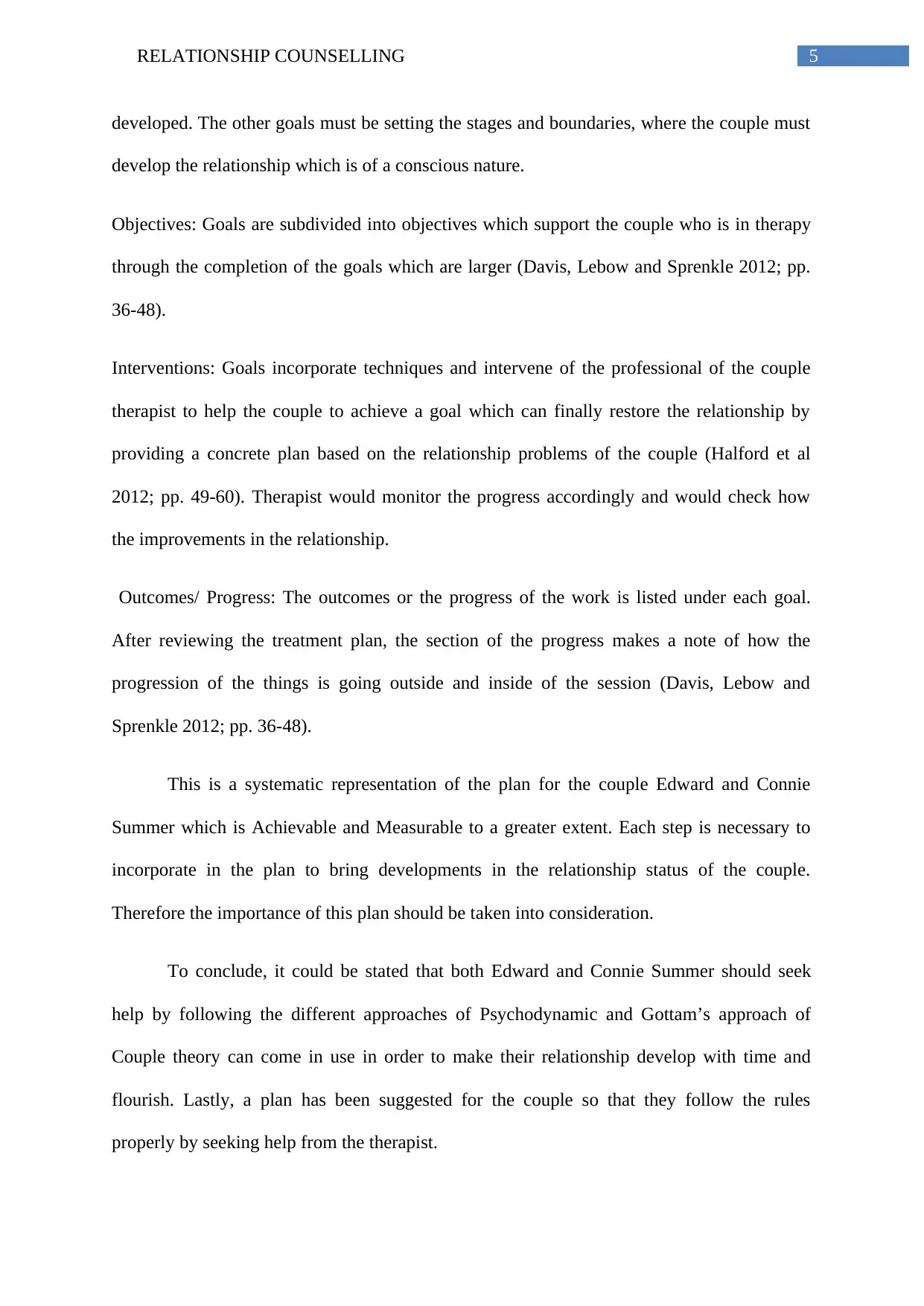
5RELATIONSHIP COUNSELLING
developed. The other goals must be setting the stages and boundaries, where the couple must
develop the relationship which is of a conscious nature.
Objectives: Goals are subdivided into objectives which support the couple who is in therapy
through the completion of the goals which are larger (Davis, Lebow and Sprenkle 2012; pp.
36-48).
Interventions: Goals incorporate techniques and intervene of the professional of the couple
therapist to help the couple to achieve a goal which can finally restore the relationship by
providing a concrete plan based on the relationship problems of the couple (Halford et al
2012; pp. 49-60). Therapist would monitor the progress accordingly and would check how
the improvements in the relationship.
Outcomes/ Progress: The outcomes or the progress of the work is listed under each goal.
After reviewing the treatment plan, the section of the progress makes a note of how the
progression of the things is going outside and inside of the session (Davis, Lebow and
Sprenkle 2012; pp. 36-48).
This is a systematic representation of the plan for the couple Edward and Connie
Summer which is Achievable and Measurable to a greater extent. Each step is necessary to
incorporate in the plan to bring developments in the relationship status of the couple.
Therefore the importance of this plan should be taken into consideration.
To conclude, it could be stated that both Edward and Connie Summer should seek
help by following the different approaches of Psychodynamic and Gottam’s approach of
Couple theory can come in use in order to make their relationship develop with time and
flourish. Lastly, a plan has been suggested for the couple so that they follow the rules
properly by seeking help from the therapist.
developed. The other goals must be setting the stages and boundaries, where the couple must
develop the relationship which is of a conscious nature.
Objectives: Goals are subdivided into objectives which support the couple who is in therapy
through the completion of the goals which are larger (Davis, Lebow and Sprenkle 2012; pp.
36-48).
Interventions: Goals incorporate techniques and intervene of the professional of the couple
therapist to help the couple to achieve a goal which can finally restore the relationship by
providing a concrete plan based on the relationship problems of the couple (Halford et al
2012; pp. 49-60). Therapist would monitor the progress accordingly and would check how
the improvements in the relationship.
Outcomes/ Progress: The outcomes or the progress of the work is listed under each goal.
After reviewing the treatment plan, the section of the progress makes a note of how the
progression of the things is going outside and inside of the session (Davis, Lebow and
Sprenkle 2012; pp. 36-48).
This is a systematic representation of the plan for the couple Edward and Connie
Summer which is Achievable and Measurable to a greater extent. Each step is necessary to
incorporate in the plan to bring developments in the relationship status of the couple.
Therefore the importance of this plan should be taken into consideration.
To conclude, it could be stated that both Edward and Connie Summer should seek
help by following the different approaches of Psychodynamic and Gottam’s approach of
Couple theory can come in use in order to make their relationship develop with time and
flourish. Lastly, a plan has been suggested for the couple so that they follow the rules
properly by seeking help from the therapist.
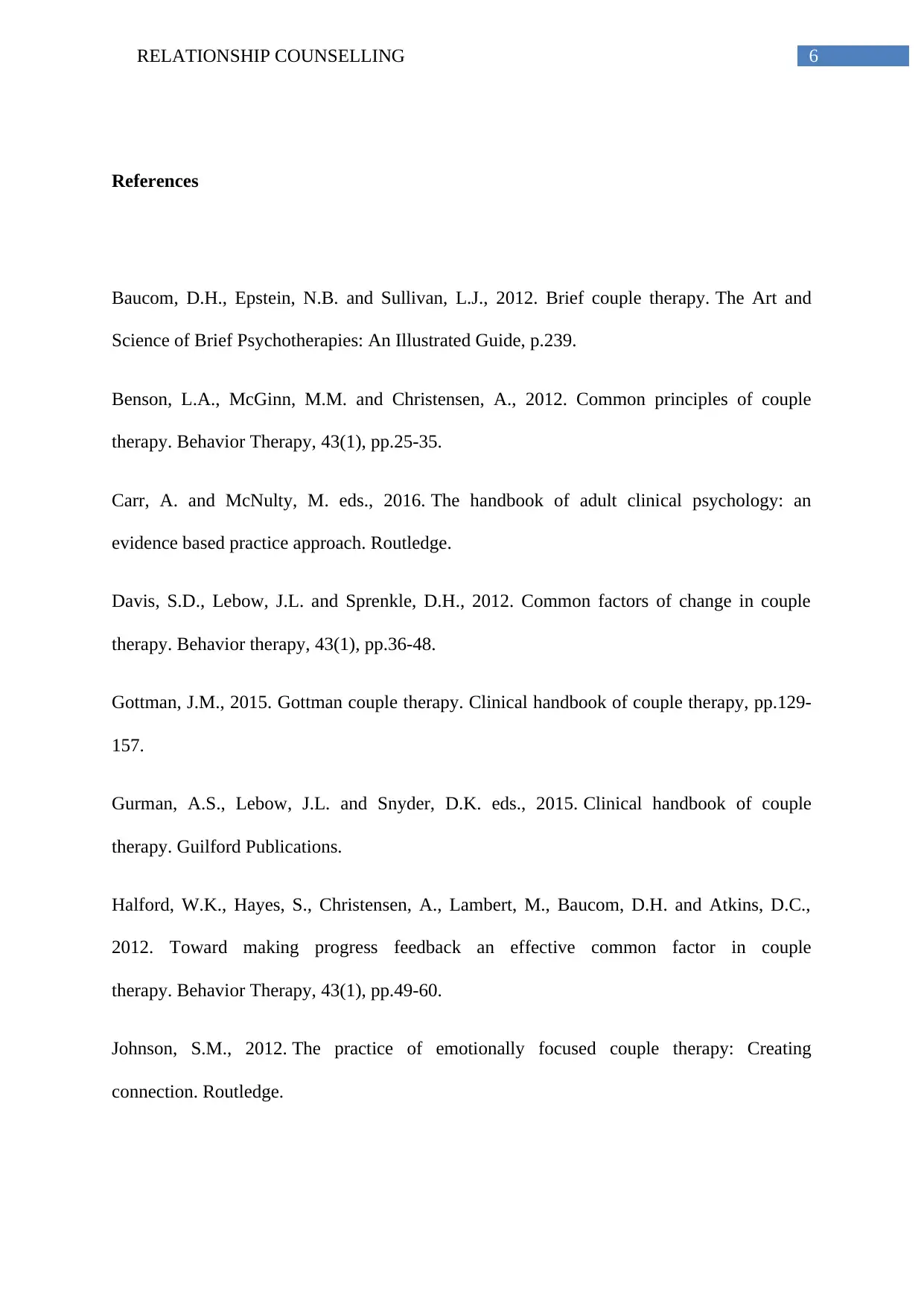
6RELATIONSHIP COUNSELLING
References
Baucom, D.H., Epstein, N.B. and Sullivan, L.J., 2012. Brief couple therapy. The Art and
Science of Brief Psychotherapies: An Illustrated Guide, p.239.
Benson, L.A., McGinn, M.M. and Christensen, A., 2012. Common principles of couple
therapy. Behavior Therapy, 43(1), pp.25-35.
Carr, A. and McNulty, M. eds., 2016. The handbook of adult clinical psychology: an
evidence based practice approach. Routledge.
Davis, S.D., Lebow, J.L. and Sprenkle, D.H., 2012. Common factors of change in couple
therapy. Behavior therapy, 43(1), pp.36-48.
Gottman, J.M., 2015. Gottman couple therapy. Clinical handbook of couple therapy, pp.129-
157.
Gurman, A.S., Lebow, J.L. and Snyder, D.K. eds., 2015. Clinical handbook of couple
therapy. Guilford Publications.
Halford, W.K., Hayes, S., Christensen, A., Lambert, M., Baucom, D.H. and Atkins, D.C.,
2012. Toward making progress feedback an effective common factor in couple
therapy. Behavior Therapy, 43(1), pp.49-60.
Johnson, S.M., 2012. The practice of emotionally focused couple therapy: Creating
connection. Routledge.
References
Baucom, D.H., Epstein, N.B. and Sullivan, L.J., 2012. Brief couple therapy. The Art and
Science of Brief Psychotherapies: An Illustrated Guide, p.239.
Benson, L.A., McGinn, M.M. and Christensen, A., 2012. Common principles of couple
therapy. Behavior Therapy, 43(1), pp.25-35.
Carr, A. and McNulty, M. eds., 2016. The handbook of adult clinical psychology: an
evidence based practice approach. Routledge.
Davis, S.D., Lebow, J.L. and Sprenkle, D.H., 2012. Common factors of change in couple
therapy. Behavior therapy, 43(1), pp.36-48.
Gottman, J.M., 2015. Gottman couple therapy. Clinical handbook of couple therapy, pp.129-
157.
Gurman, A.S., Lebow, J.L. and Snyder, D.K. eds., 2015. Clinical handbook of couple
therapy. Guilford Publications.
Halford, W.K., Hayes, S., Christensen, A., Lambert, M., Baucom, D.H. and Atkins, D.C.,
2012. Toward making progress feedback an effective common factor in couple
therapy. Behavior Therapy, 43(1), pp.49-60.
Johnson, S.M., 2012. The practice of emotionally focused couple therapy: Creating
connection. Routledge.
Paraphrase This Document
Need a fresh take? Get an instant paraphrase of this document with our AI Paraphraser
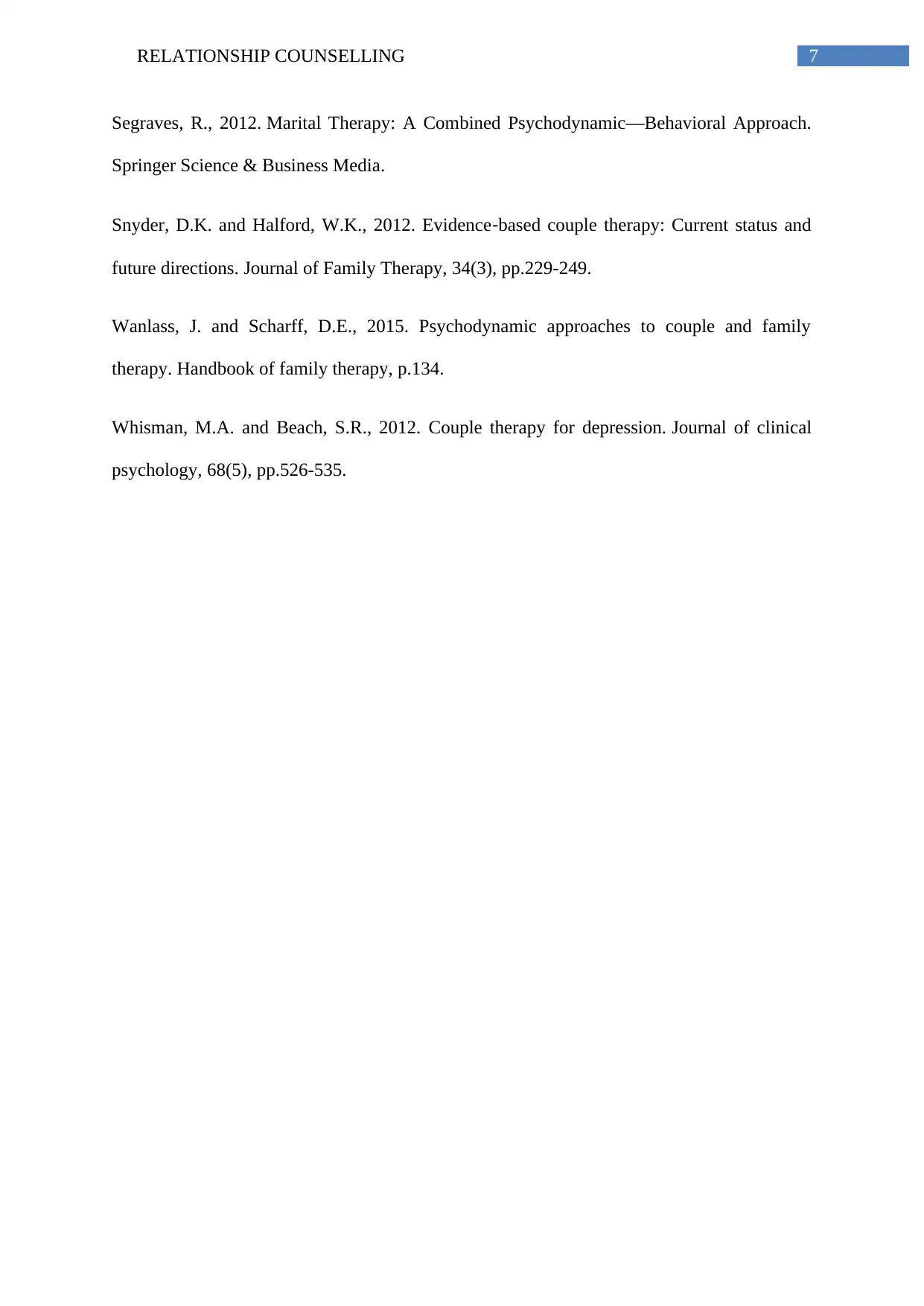
7RELATIONSHIP COUNSELLING
Segraves, R., 2012. Marital Therapy: A Combined Psychodynamic—Behavioral Approach.
Springer Science & Business Media.
Snyder, D.K. and Halford, W.K., 2012. Evidence‐based couple therapy: Current status and
future directions. Journal of Family Therapy, 34(3), pp.229-249.
Wanlass, J. and Scharff, D.E., 2015. Psychodynamic approaches to couple and family
therapy. Handbook of family therapy, p.134.
Whisman, M.A. and Beach, S.R., 2012. Couple therapy for depression. Journal of clinical
psychology, 68(5), pp.526-535.
Segraves, R., 2012. Marital Therapy: A Combined Psychodynamic—Behavioral Approach.
Springer Science & Business Media.
Snyder, D.K. and Halford, W.K., 2012. Evidence‐based couple therapy: Current status and
future directions. Journal of Family Therapy, 34(3), pp.229-249.
Wanlass, J. and Scharff, D.E., 2015. Psychodynamic approaches to couple and family
therapy. Handbook of family therapy, p.134.
Whisman, M.A. and Beach, S.R., 2012. Couple therapy for depression. Journal of clinical
psychology, 68(5), pp.526-535.
1 out of 8
Your All-in-One AI-Powered Toolkit for Academic Success.
+13062052269
info@desklib.com
Available 24*7 on WhatsApp / Email
![[object Object]](/_next/static/media/star-bottom.7253800d.svg)
Unlock your academic potential
© 2024 | Zucol Services PVT LTD | All rights reserved.